Natural Resource Utilization
The Kikkoman Group implements initiatives to reduce food loss and develop environmentally friendly products to effectively utilize precious resources.
As a measure to reduce food loss, we are cutting down on waste materials generated during production and distribution.
Production Department Initiatives: Upcycling of Byproducts and Waste Materials
Through measures such as enhancing yield and improving on production processes, the Kikkoman Group is working to reduce, reuse, and make effective use of, commonly referred to as “upcycle”, byproducts such as soy sauce cake, soy sauce oil, soybean powder, fruit pulp after juicing, okara (soy pulp), and processing wastes such as sludge.
Upcycling Soy Sauce Cake
Soy sauce cake has been used as fuel, fertilizer, and livestock feed. The Kikkoman Corporation has been researching the utility of soy sauce cake as feed since 2004, and in 2007 introduced soy sauce cake bagging facilities in our plants. We also developed and expanded feed sales channels. In 2020, we switched to an automated bagging process, enabling the production of highly hygienic feed and labor-saving. Soy sauce cake contains fat, vitamin E, vitamin K1, isoflavones and other functional ingredients derived from soybeans, making it ideal for feeding to cattle, pigs, and poultry. The Kikkoman Food Products Company offers almost all our soy sauce cake to livestock farmers through feed suppliers.
Furthermore, in 2000, the Kikkoman Group collaborated with a paper manufacturing company to develop technology that mixes soy sauce cake with non-wood pulp to produce paper products. Now, these paper products are used for business cards and more.
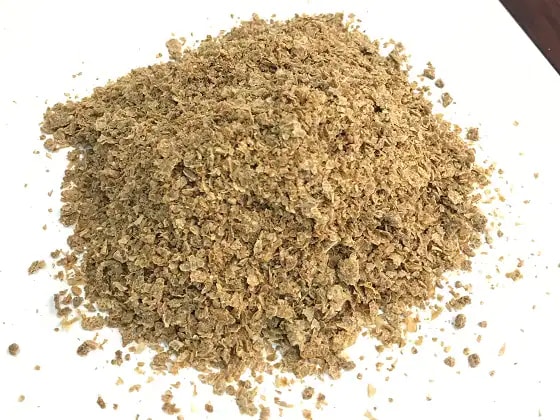
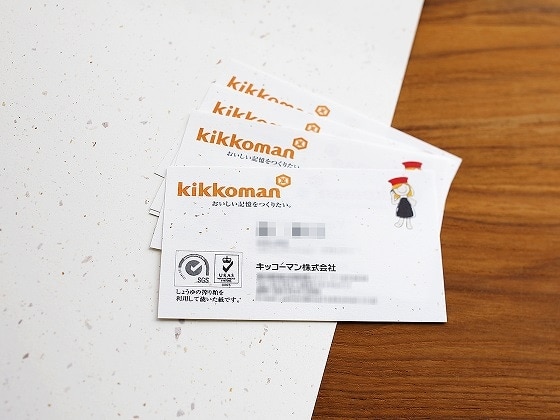
Business cards printed on soy sauce cake blended paper
Upcycling Soy Sauce Oil
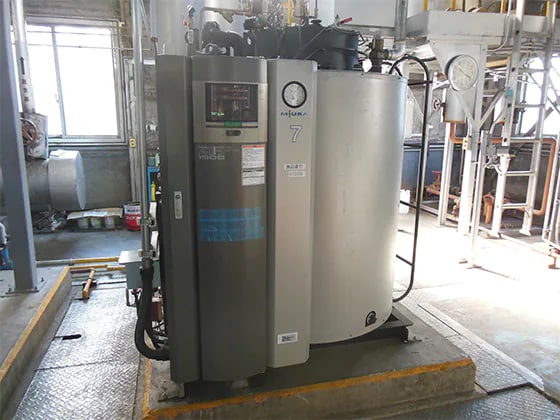
A large amount of soybean oil is contained in raw soy sauce immediately after pressing. Once stored in a clarifier tank, the oil floats to the top. This “soy sauce oil” has been used as fuel (lamp oil in the Edo era), a material for soap, and machine oil.
Since 1994, the Kikkoman Food Products Company has proactively reduced its consumption of fossil fuel by utilizing most of the soy sauce oil generated from soy sauce production as carbon-neutral fuel.
Innovative Utilization of Soybean Powder
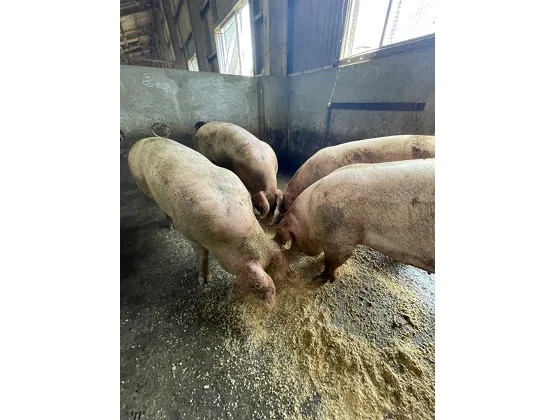
In June 2022, the Noda Factory of Kikkoman Food Products Company offered 220 kg (485 lbs) of soybean powder generated in soy sauce production to the Chiba Prefectural Agricultural College to support their research on “the value of unused resources as livestock feed.” The college planned to feed the soybean powder to pigs in the late fattening phase, and investigate growth performance, sensory evaluation, and economic efficiency with the aim of confirming its feed value. Until then, soybean powder had been disposed of as industrial waste material. If determined to be valuable as livestock feed, this research will contribute not only to livestock agriculture but also to environmental conservation efforts, such as the reduction of CO2 emissions generated from industrial waste disposal.
Upcycling Okara
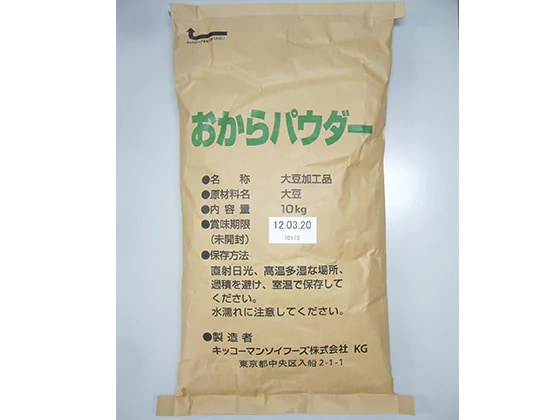
The Kikkoman Soyfoods Company produces and sells soymilk products such as original soymilk and unsweetened soymilk.
Soymilk is produced by boiling, grinding, and pressing soybeans. The residue that remains after pressing is called “okara”, also known as soy pulp.
The Kikkoman Soyfoods Company then dehydrates and powderizes the okara for sale as a food ingredient.
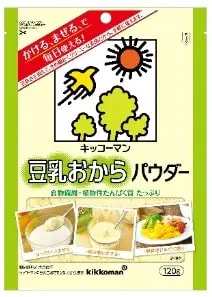
(120 g / 4.2 oz. plastic bag)
In 2018, we began sales of the okara product “Kikkoman Soymilk Okara Powder” for household use.
Kikkoman Soymilk Okara Powder is rich in soybean nutrients such as dietary fiber and vegetable protein. Just one tablespoon of this powder contains dietary fiber equivalent to appx. 1/2 head of lettuce (calculated based on STANDARD TABLES OF FOOD COMPOSITION IN JAPAN - 2015). Having a fine and smooth texture, our okara powder readily dissolves when mixed into liquids to create a melt-in-your-mouth sensation. In addition, the Kikkoman Soyfoods Company’s unique technology for producing soymilk reduces soybean odor and draws out the characteristic mild soybean flavor of okara. Simply mix into yogurt, smoothies, miso and other soups to easily incorporate soybean nutrients daily without affecting the flavor of food. Also, prepare “gluten-free” meals by substituting okara powder for flour in pancake batter, and as a thickener for curry and a variety of stews and sauces.
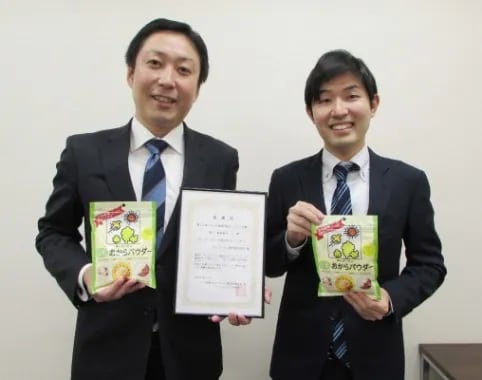
The 25th Tasukarimashita (Helpful Product)
Award (food and beverage category)
Kikkoman Soymilk Okara Powder received recognition with the 25th Tasukarimashita (Helpful Product) Award (one of ten annual awards in the food and beverage category) presented by the SANKEI LIVING SHIMBUN Inc. for its ease of use in cooking.
Upcycling Sludge
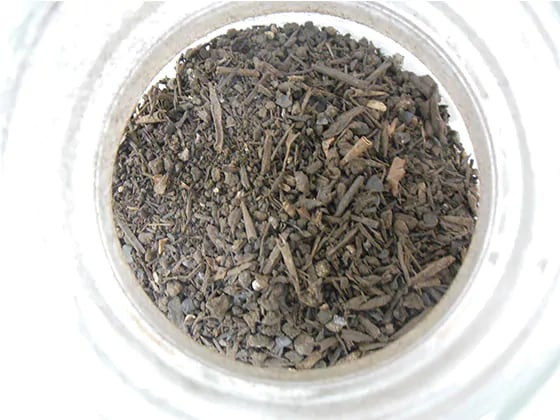
The Kikkoman Group takes full precautions to prevent the pollution of waterways by first treating wastewater generated during production processes at water purification facilities installed next to our plants before release. The resultant muddy sediment and floating materials at water purification facilities are called “sludge.”
The Kikkoman Food Products Company’s Noda Plant and the Nagareyama Kikkoman Co., Ltd. take all (100%) sludge accumulated at our water purification facilities and convert it into fermented fertilizer. This fertilizer is then offered to farmers growing sweet potatoes and strawberries.
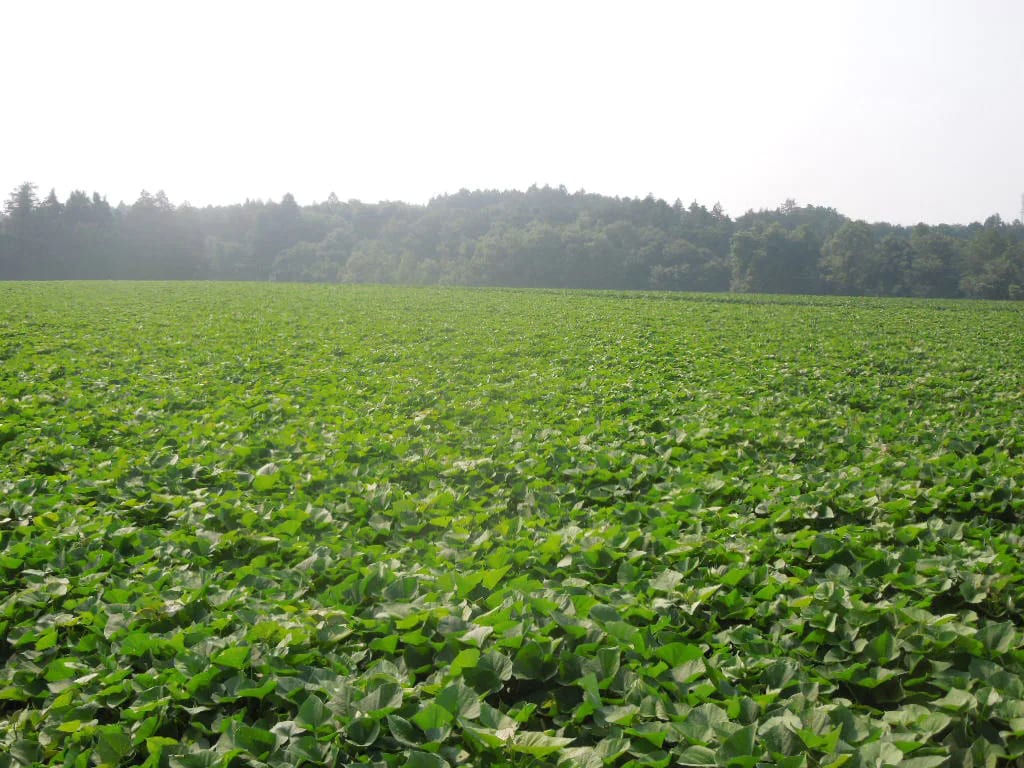
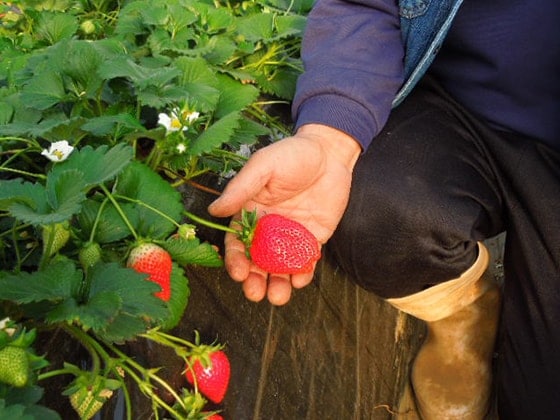
Fermented fertilizer made from sludge is rich in nitrogen and phosphorus, making it well-suited for cultivating agricultural crops. Additionally, a portion of the sludge generated at the Kikkoman Biochemifa Kamogawa Plant is mixed with waste oil and reused as solid fuel.
Effective Use of Diatomaceous Earth
At KSP (Kikkoman Singapore Pte. Ltd.), our soy sauce production company in Singapore, we are effectively utilizing diatomaceous earth, which we use as a filtration aid. We began considering the previously used and discarded diatomaceous earth as a resource, and now reuse it as tree nurseries after it is mixed and fermented by a specialized company.
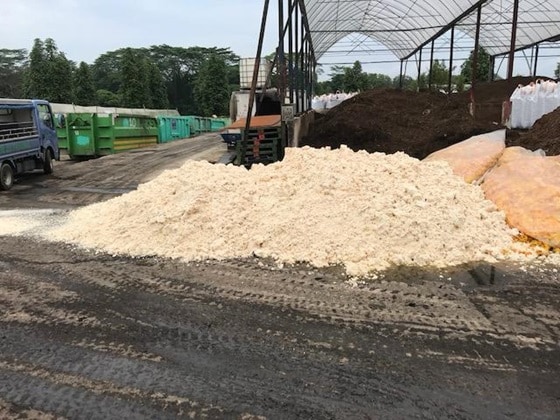
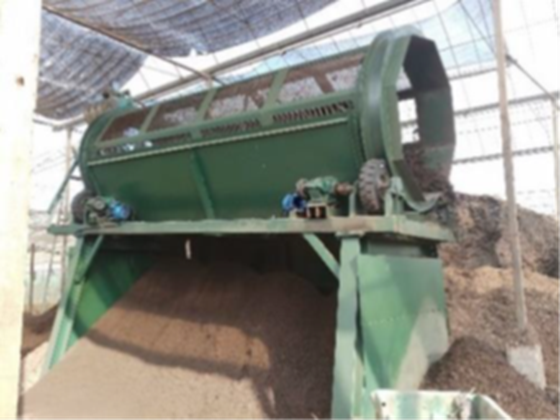
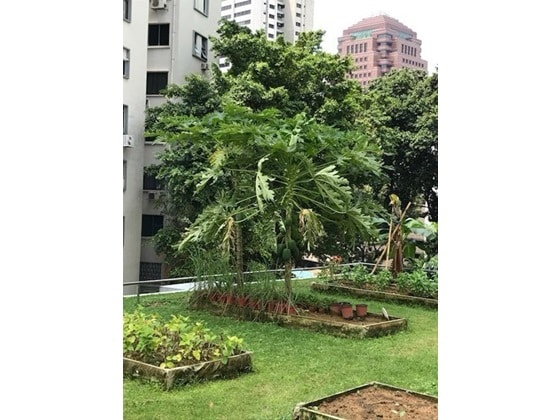
Research & Development for Upcycling Byproducts
The Kikkoman Group prioritizes quality improvements for byproduct utilization. For this purpose, we conduct research and development (R&D) activities.
One example is an R&D study on the use of soy sauce oil as fish feed. The Kikkoman Research & Development Division discovered the effectiveness of soy sauce oil consisting of fatty acid ethyl esters (approx. 59%), containing linoleic acid and oleic acid from soybeans and free fatty acids (approx. 15%), as a substitute for conventional fish feed made from “sardine oil.” The R&D Division also found other functions such as antioxidant activity and antibacterial activity in resisting fish disease bacteria. This study on the development of a new usage for byproducts was highly evaluated by specialists, and the Kikkoman Research & Development Division received the 2003 Director-General's Award of the Industrial Technology and Environment Bureau, Ministry of Economy, Trade and Industry.
Grape seeds discarded during wine production at the Manns Wines Co., Ltd. had been used as fertilizer. However, joint research by Kikkoman and Manns Wines discovered that polyphenols (proanthocyanidins) contained in grape seeds have a strong antioxidant action, and proceeded to develop a proprietary method for its effective extraction. These research results were highly evaluated by specialists and given recognition with the FY 1999 Award for Achievement in Technological Research by the Japan Society for Bioscience, Biotechnology and Agrochemistry (JSBBA).
In addition, tomato peel removed during tomato juice production at the Nippon Del Monte Corporation’s Nagano Factory in Chikuma City, Nagano Prefecture, had been reused by treatment contractors as livestock feed. However, in an R&D study conducted with the Mibyo Medical Research Center (“Mibyo” is Japanese for “Pre-Disease”), Kikkoman discovered that tomato peel containing polyphenol (naringenin chalcone) has strong anti-allergy activity which aids in relieving symptoms of pollen allergies.
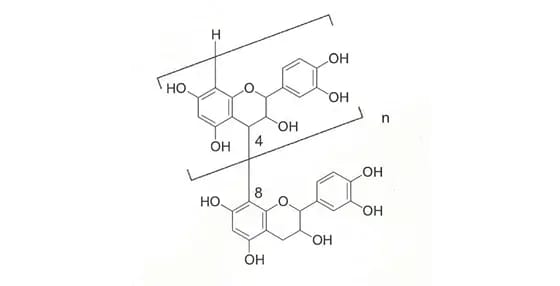
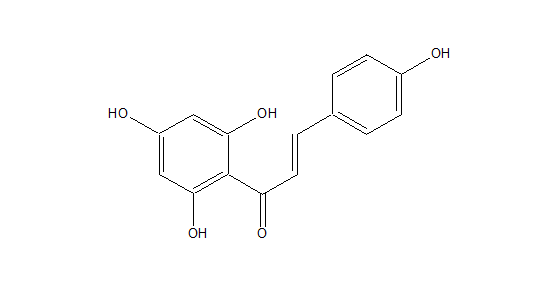
Naringenin chalcone (tomato peel polyphenols)
Initiatives for Food Loss Reduction
Food Sustainability Seminars
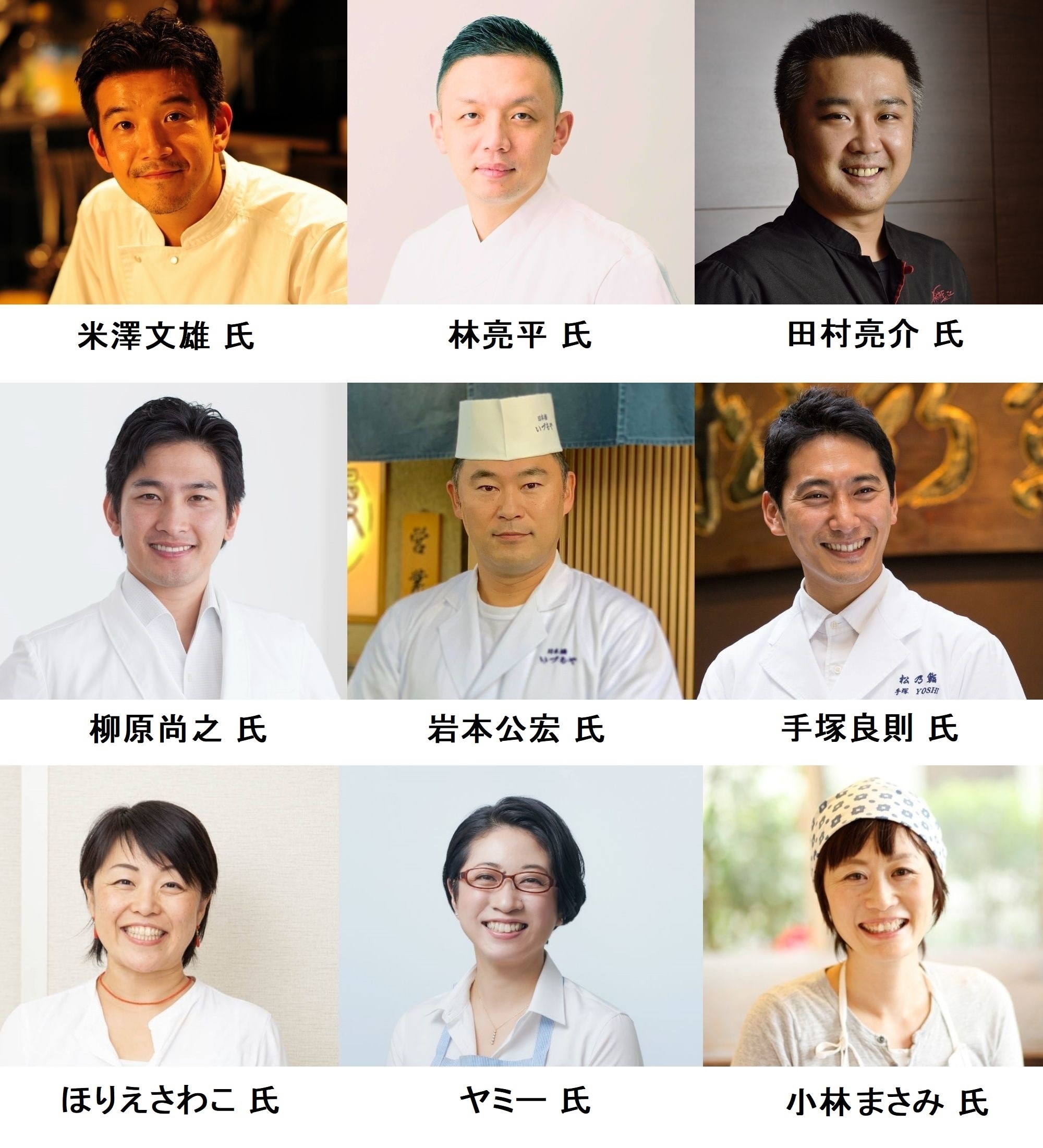
On three occasions between January and March in 2022, Kikkoman held cooking seminars (YouTube live streams). Themed "Delicious food for the earth and the future of food - Food sustainability we can do", these seminars were special events organized by the KCC* Food Culture and Cooking Workshop, and featured food professionals from several different genres. Participants learned recipes incorporating measures for "food loss reduction and resource conservation" and had an opportunity to think about the global environment through familiar "meals."
*Kikkoman Corporation’s Consumer Community Cooking Culture Communication
Webpage Featuring “Leftovers” Recipes
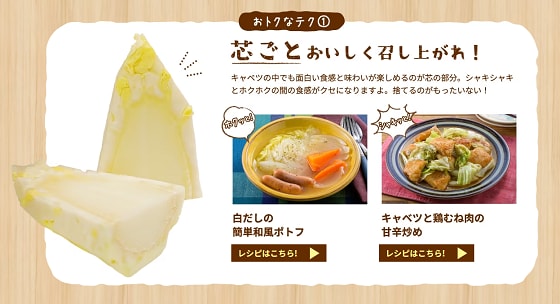
In March 2023, the Kikkoman Food Products Company launched a feature webpage on our Japanese website focused on supporting the reduction of food loss in consumer kitchens called, “Search Our Fridge for Leftovers Recipe Ideas!”.
In Japan, it is said that about half of food waste is generated by households. Kikkoman's research has shown that large vegetables, such as cabbage, hakusai (napa or Chinese cabbage), and daikon radish, as well as seasonings with limited uses, such as barbecue sauce and tomato ketchup, are often not used up at home.
The webpage introduces recommended recipes to use up these leftover vegetables and seasonings. It provides delicious meal ideas using parts often thrown away, such as cabbage cores and the outer leaves of hakusai. The webpage also suggests ways to store food for extended shelf life.
Office Space Initiatives
Reduced Paper Usage
Beginning with our Noda Plant that acquired ISO 14001 certification in 1997, the principal business sites of the Kikkoman Group in Japan, such as the Noda Head Office, the Tokyo Head Office, and all sites of the Kikkoman Food Products Company, the Nippon Del Monte Corporation, and the Manns Wines Co., Ltd. have set goals to reduce amounts of paper used, as one of our initiatives to minimize waste. To achieve this, we utilize blank sides of paper, paperless purchase order forms and meeting materials, and avoid unnecessary printouts. If printouts are required, as a general rule, we recommend our employees to use environmentally friendly paper certified by the FSC (*1) or the PEFC (*2).
- (*1)FSC-Certified Paper: Paper certified under a global standard set by an organization (the FSC: Forest Stewardship Council) that verifies materials provided from properly managed forests in terms of environmental and social sustainability have been delivered to consumers after appropriate processing and distribution.
- (*2)PEFC-Certified Paper: Paper certified by a program (the PEFC: Programme for the Endorsement of Forest Certification), which conducts mutual authorization with certification systems in multiple countries based on Pan-European industrial guidelines.
Centralized Storage Spaces for Office Supplies
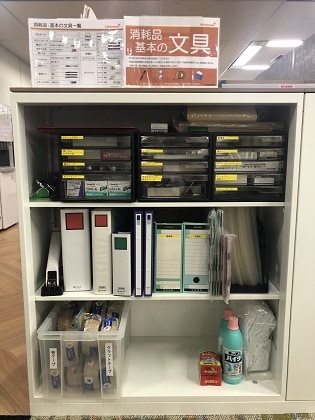
(Kikkoman’s Tokyo Head Office)
Kikkoman's Tokyo Head Office has set up “Centralized Storage Spaces for Office Supplies and Basic Stationery”. The head office collectively purchases and manages office supplies used by Kikkoman Group companies in Japan to improve operational efficiency and save costs. In addition, the office collects used office supplies (such as paper clips and clear files) in these storage spaces to encourage reuse, which has also led to reduced costs and waste.
Recycling Office Paper as Coasters
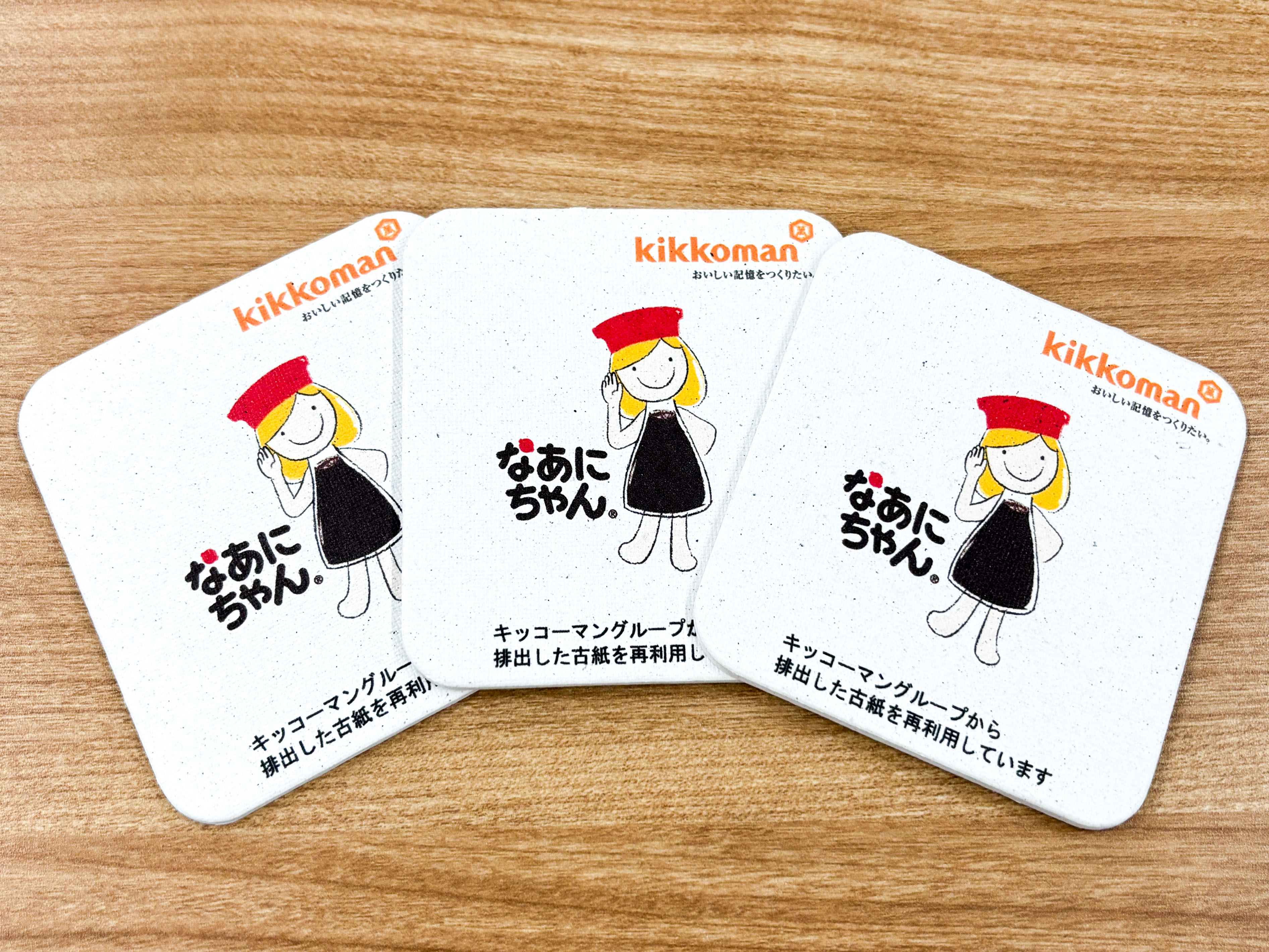
At the Kikkoman Noda Head Office, office paper discarded as waste is recycled into coasters for use in the reception room.Each coaster, made from 2 to 3 sheets of A4 paper, is water repellent and reusable.
The Kikkoman brand mascot, “Kikona,” is featured on the coasters.
